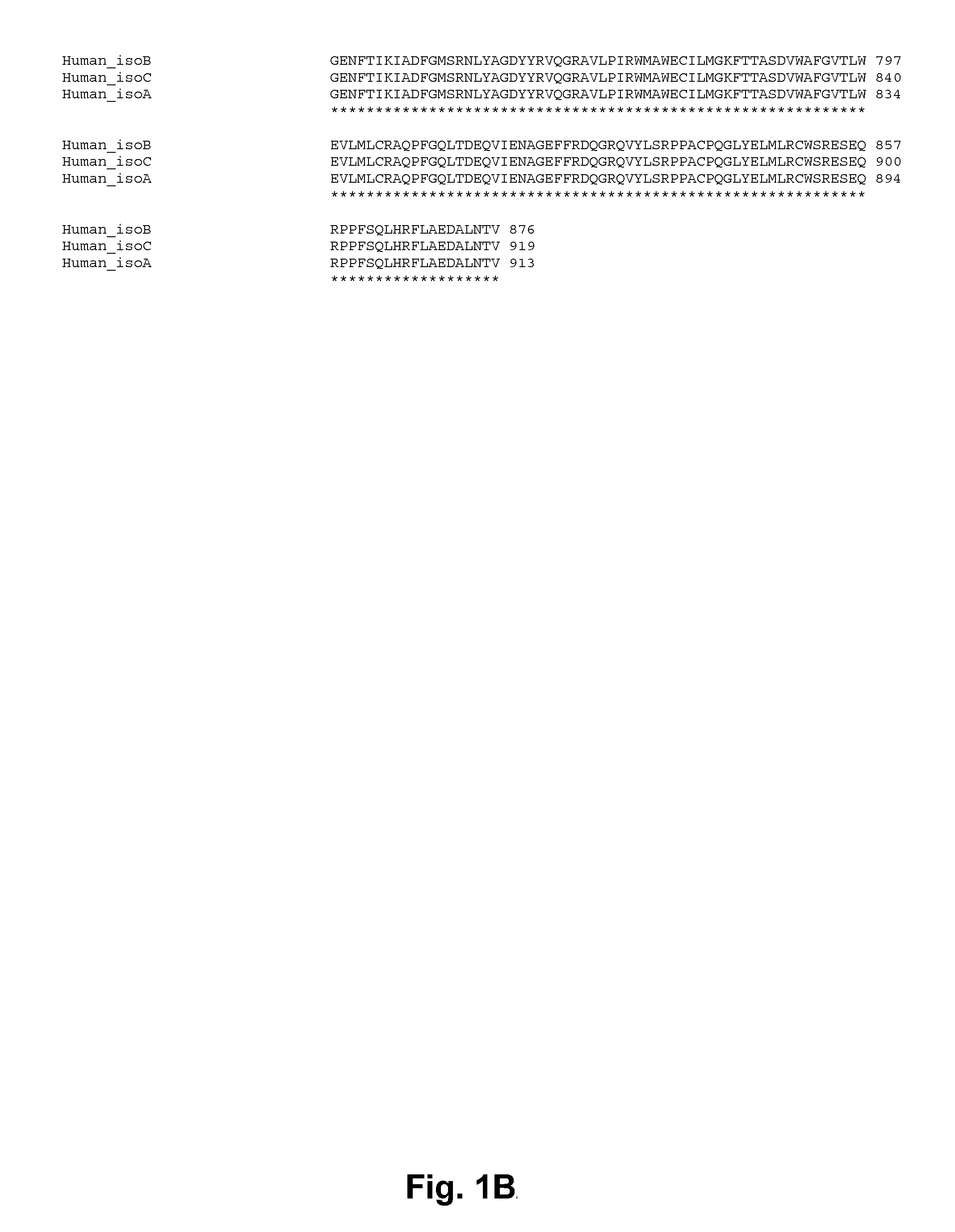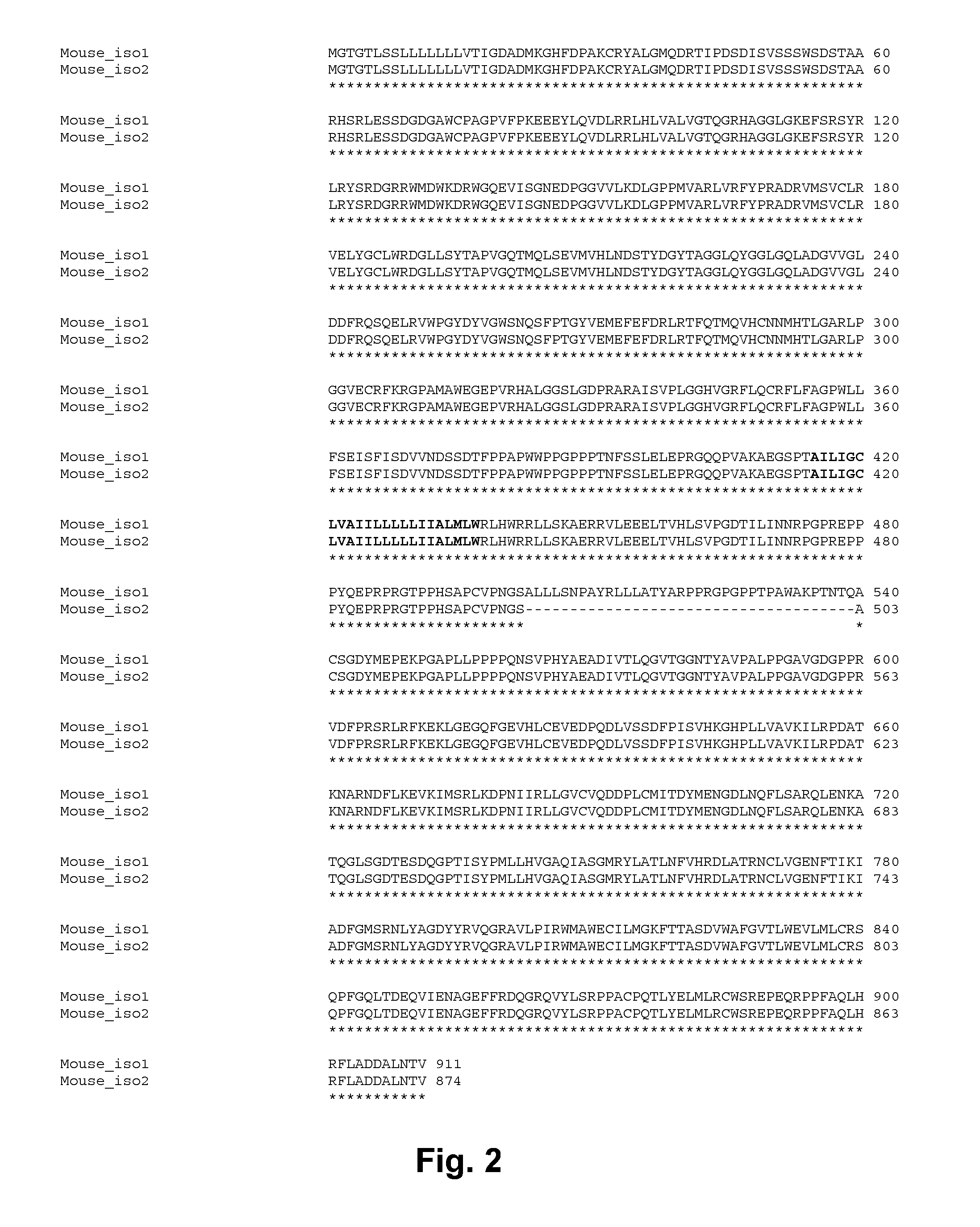DDR1-mediated cell purification of pancreatic endocrine cells through their progenitors
a pancreatic endocrine cell and purification technology, applied in the field of selective cell surface markers ddr1, can solve the problems of insufficient development of reliable protocols for generating inability to reliably differentiate fully functional beta cells, and inability to obtain donor islets, etc., to achieve the effect of facilitating cell differentiation
- Summary
- Abstract
- Description
- Claims
- Application Information
AI Technical Summary
Benefits of technology
Problems solved by technology
Method used
Image
Examples
example 1
Bioinformatic Analysis of Mouse Ddr1 and Human DDR1
[0167]To investigate the amino acid differences between the three isotypes of DDR1 in human (FIG. 1) and the two isotypes found in mouse (FIG. 2) the amino acid sequence of the proteins were aligned by the use of Clustal W (at http: / / www.ebi.ac.uk / Tools / clustalw2 / index.html). To find the extracellular and transmembrane domains all isotypes were passed through the transmembrane predictor TMHMM Server v. 2.0 at CBS (http: / / www.cbs.dtu.dk / services / TMHMM / ) (data only shown for the longest forms of mouse Ddr1: Isoform 1) and the longest forms of human DDR1: Isoform c). This showed that all three human isotypes had transmembrane domain in the same place, namely amino acid 417-439 (FIG. 1 bold) and the two mouse isotypes had the domain at amino acid 415-437 (FIG. 2 bold). This established that the three human isotypes of DDR1 and the two mouse isotypes of Ddr1 had the same amino acid sequence on the extracellular side, respectively. Specif...
example 2
Investigation of Isotypes Expressed in e15.5 Mouse Gut
[0170]A PCR was performed on cDNA from e15.5 mouse gut tissue (including pancreas, stomach, duodenum and spleen). The PCR was performed under standard conditions (97 degrees for 180 seconds then 35 cycles of 96 degrees for 30 seconds, 55 degrees for 30 seconds and 72 degrees for 30 seconds) with primers flanking the 37 amino acids missing in isoform 2 compared to isoform 1.
[0171]The results showed that Ddr1 isoform 1 (911 aa) exhibited higher expression levels than isoform 2 in e15.5 mouse gut. PCR primers located on either side of the sequence coding for the 37 amino acids missing in isoform 2 amplified either a 328 by fragment when isoform 1 was the template or 215 by if isoform 2 was the template. cDNA from e15.5 gut tissue was used as template. From a semi quantitative gel it was observed that both isoforms were expressed in the gut and that isoform 1 was expressed at higher levels than isoform 2.
[0172]Two bands are observed ...
example 3
Investigation of the Expression Pattern of Ddr1 in Mouse
[0173]In-situ hybridisation (ISH) for Ddr1 in the mouse pancreas was done by using a digoxigenin labelled cRNA probes generated by in vitro transcription using reagents from Roche according to manufacturer's instruction. Frozen sections were thawed and denatured cRNA probes diluted to 1 ng / μl in hybridization solution were added directly to the sections. The sections were covered with a cover slip and placed in a humidified chamber at 65° C. over night. The slides were washed in wash solution at 65° C. followed by several washes in MABT at room temperature. The sections were blocked for 1 hour and incubated over night with an AP conjugated sheep-anti-DIG (Roche). The sections were washed in MABT and then equilibrated in NTMT. AP activity was visualized with NBT / BCIP in NTMT.
[0174]It was observed that the ISH signal for Ddr1 became more and more restricted the older the embryos were. At e12.5 all cells in the pancreas were posit...
PUM
| Property | Measurement | Unit |
|---|---|---|
| pH | aaaaa | aaaaa |
| temperature | aaaaa | aaaaa |
| temperature | aaaaa | aaaaa |
Abstract
Description
Claims
Application Information
 Login to View More
Login to View More - R&D
- Intellectual Property
- Life Sciences
- Materials
- Tech Scout
- Unparalleled Data Quality
- Higher Quality Content
- 60% Fewer Hallucinations
Browse by: Latest US Patents, China's latest patents, Technical Efficacy Thesaurus, Application Domain, Technology Topic, Popular Technical Reports.
© 2025 PatSnap. All rights reserved.Legal|Privacy policy|Modern Slavery Act Transparency Statement|Sitemap|About US| Contact US: help@patsnap.com



